Omanisation squeezes the property market
Even before the pandemic, Oman’s property market was already depressed, due to the imposition of expatriate visa ban coupled with an increasing supply glut. The situation further deteriorated this year after the Omani government closed its borders to international tourists beginning March 2020 to prevent the spread of the virus.
“As Oman pushes ahead with its Omanisation drive, the number of expats leaving the country as a result of visa bans for foreign workers has increased, sending property rents and prices lower,” said Cavendish Maxwell Research.
Residential property prices and rents have been falling by about 10% to 15% annually in the past three years, according to local real estate experts.
The Ministry of Manpower first introduced the expatriate visa ban in January 2018, in an effort to reduce the number of unemployed locals as part of the Omanization project. The ban has been extended several times since. Earlier this year, the government has decided to extend again the visa ban on expats for another six months from August 5, 2020, and has expanded the coverage to include more job categories.
Foreigners account for almost 90% of all workers in Oman’s private sector. The expat population rose by more than 12% per annum during the period 2004-2016 but has continuously declined since the visa ban was introduced. In the first half of 2020, the total number of expat workers in Oman fell by a huge 9.3% y-o-y to 1,589,883, following annual declines of 4.2% in 2019 and 3.6% in 2018.
“We expect to see an on-going decline in the expatriate population living in Muscat and that will result in a reduced market size and therefore reduced demand over the coming months,” said Matthew Wright of Savills Oman.
Real estate trades plunged 24% during the first eight months of 2020, as compared to the same period last year, according to the National Centre for Statistics & Information (NCSI), with the value of properties falling by 7.3% y-o-y.
Oman’s real estate market began to be opened to foreigners in 2002, as part of the “Vision 2020” plan to reduce Oman’s oil-dependence. GCC nationals were the first foreigners to gain the right to own real estate, then in February 2006 other nationalities, but only in designated Integrated Tourism Complexes (ITCs). Under current laws, expatriate owners automatically get residency rights for themselves and immediate families when they buy property in ITC developments.

The Omani economy grew by a minuscule 0.5% in 2019, a slowdown from the previous year’s 1.8% growth – and far lower than the annual average growth rate of 5% from 2012 to 2016, according to the International Monetary Fund (IMF).
The IMF has recently forecast that Oman’s economy will contract by 2.8% this year, mainly due to the coronavirus outbreak, as well as the oil price slide.
In August 2020, crude oil prices stood at an average of US$ 44.74 per barrel, sharply up from just US$18.38 in April 2020 but down from last year’s US$59.04 per barrel.
Integrated Tourism Complexes
The major ITCs such as Al Mouj Muscat (formerly The Wave), Muscat Bay (formerly Saraya Bandar Jissah), and Muscat Hills Golf and Country Club have led the country’s housing market in terms of growth and price increases. These ITC developments have continuously attracted owners and tenants, with low vacancies and high rents, due to their superior design, setting and facilities.
However as Oman pushes ahead with its Omanisation, the number of expats leaving the Sultanate has caused property prices and rents to fall.
In 2019, the total number of expats in Oman stood at 1,972,088, down by 2.9% from a year earlier, based on figures from the NCSI.
In Al Mouj Muscat, (formerly known as The Wave), the average price of a one-bedroom apartment was OMR 105,000 (US$ 272,400) in 2019, according to Cavendish Maxwell Research’s Oman Property Market Report 2019-2020. Over the same period, two-bedroom and three-bedroom apartments were priced OMR142,000 (US$368,400) and OMR150,000 (US$389,100), respectively. Villas in the area are offered from OMR 187,500 (US$486,400) for two-bedroom units to OMR 780,000 (US$2.02 million) for six-bedroom properties.
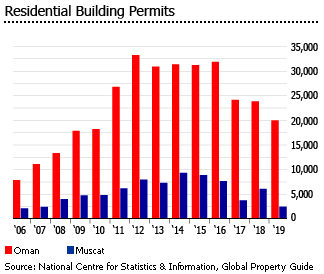
In Muscat Hills, the average price of one-bedroom apartments stood at OMR73,000 (US$ 189,400) last year. Prices of two- and four-bedroom apartments ranged from OMR108,000 (US$280,200) to OMR210,000 (US$544,800). Five-bedroom villas are sold for about OMR558,000 (US$1.45 million).
RESIDENTIAL PROPERTY PRICES, 2019 |
||||
| Property price (OMR) | Property price (USD) | |||
| Property type | Lowest | Highest | Lowest | Highest |
| APARTMENT | ||||
| 1-bedroom | 38,000 | 105,000 | 98,600 | 272,400 |
| 2-bedroom | 50,000 | 142,000 | 129,700 | 368,400 |
| 3-bedroom | 70,000 | 150,000 | 181,600 | 389,100 |
| VILLA | ||||
| 3-bedroom | 130,000 | 303,000 | 337,300 | 786,100 |
| 4-bedroom | 180,000 | 440,000 | 467,000 | 1,141,500 |
| 5-bedroom | 222,000 | 558,000 | 575,900 | 1,447,600 |
| Sources: Cavendish Maxwell Research, Global Property Guide | ||||
Aside from ITCs, there have been significant ‘off plan’ sales of new apartment developments in the Muscat neighborhood.
Newly launched off-plan apartment developments in Oman:
- In Qurum, Muscat’s upmarket suburb, one-bedroom apartments are sold for about OMR 48,000 (US$124,500). Prices of two- and three-bedroom apartments were OMR55,000 (US$142,700) and OMR 70,000 (US$181,600), respectively, according to Cavendish Maxwell Research.
- In Al Khuwair, two-bedroom apartments are priced OMR 74,000 (US$192,000) while three-bedroom apartments are offered for OMR 88,000 (US$228,300). Prices of five- and six-bedroom villas were OMR222,000 (US$576,000) and OMR 245,000 (US$635,600).
- In Bawshar, one of the newly established residential areas in Muscat, one-bedroom apartments are priced OMR 38,000 (US$98,600); two-bedroom apartments for OMR 50,000 (US$129,700); and three-bedroom apartments for OMR 79,000 (US$204,900).
Oman will open more areas to expat homebuyers
Despite Omanisation, the government is opening up more areas for expats and foreign homebuyers, stressing tourism.
The Ministry of Tourism has recently signed an agreement with Amouage Hotels and Resorts for the development of Naseem A’Sabah, an integrated tourism complex worth OMR300 million (US$779.3 million). This will be located on North Al Mawleh Beach, in the governate of A’Seeb and will feature two hotels with a total capacity of 600 rooms, 696 housing units, and a marina with berths for 75 boats and a sales gallery.
“Any expatriate living in the country can own a house in this first project that is built on the sea-reclaimed land off Mawaleh,” said Tourism Minister Ahmed bin Nasser al Mehrzi.
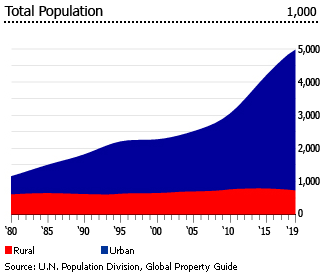
“This project is part of our Oman Tourism Vision 2040 and with this, we aspire to achieve rapid development of tourism in the Sultanate,” the tourism minister added.
Construction works for Qurayyat Project, a OMR360 million (US$935.1 million) integrated tourism complex, is expected to begin this year. It will feature more than 3,000 residential units, as well as hotels, a golf course, a water park, cinemas, restaurants, and a health club. The project will be located in Wilayat Qurayyat over an area of about 1.3 million sq. m. and will be developed in three phases over a period of 15 years.
Another mixed-use ITC project, Al Nakheel, will be developed on the Abu Nakheel coastline in Al Rumais, Barka. This 500,000-sq. m. project is worth OMR 246 million (US$639 million) and will include three hotels, 185 hotel apartments, 1,436 residential units, an artificial lagoon and water part, a traditional souq and an international school.
Sur Gate Project, a 146,000 sq. m. integrated complex located in Al Sharqiyah, is currently under construction. It is worth OMR 120 million (US$311.7 million) and offers residential apartments and villas alongside a hotel, mall, and leisure centre.
Other ongoing ITC projects in Oman include Diyar Ras Al Hadd Resort with 700 residential units, Omagine Project with 2,000 units, and Hawana Lagoons Salalah with 260 units. The government is expected to add another two mega projects this year: Madinat Al Irfan and Yeti.
Demand is plummeting
In the first eight months of 2020:
- The number of sales contracts fell by 15.2% y-o-y to 32,460 units amounting to OMR 510 million (US$ 1.32 billion)
- The number of mortgage contracts dropped 25.8% y-o-y to 7,989 units amounting to OMR 965.1 million (US$ 2.5 billion)
In August 2020, North Al-Batinah recorded the highest number of sales transactions in Oman, followed by South Al-Batinah, Al-Dakhiliya, Muscat, South Al Sharqiyah, and North Al Sharqiyah.

Last year, real estate units traded fell by 5.5%, but transactions values increased 4.9%.
Residential construction is falling
Despite the ITC projects, residential building permits in Oman fell by 16.2% to 20,007 units in 2019, according to the NCSI.
This is considerably down from the average of 29,200 units in 2011-18, but up from an annual average of 15,000 units in 2007-10 and 7,000 units in 2002-06.

Muscat showed a similar pattern, with the number of residential building permits falling by a whopping 58.7% to 2,534 units in 2019 from a year earlier.
Rents continue to fall; expat visa ban extended
Savills Oman notes that apartment rents started to fall during the second half of 2015 and have been declining since then – in 2019 they were about 30% to 40% lower than in 2014. Rental values have fallen further this year, by about 10% to 20% since the start of 2020, according to Matthew Wright of Savills Oman.
“The projected drop in the number of expatriates in Muscat over the coming months will place the residential market under increased downward pressure in terms of both reduced demand and achievable rental values,” said Savills Oman.
Early this year, the Ministry of Manpower decided to extend again the temporary visa ban on expats for another six months from August 5, 2020, as part of the government’s efforts to create more jobs for Omanis and reduce unemployment. The new guidelines added “sales representatives/sales promoter” and “purchase representative” to the long list of job categories from which expats are banned.
Foreigners account for almost 90% of all workers in Oman’s private sector, according to the Manpower Ministry. The expat population rose by more than 12% per annum during the period 2004-2016. But in recent years thousands of expats have been leaving the Sultanate because of the expat visa ban. In the first half of 2020, the total number of expat workers in Oman fell by a huge 9.3% y-o-y to 1,589,883, following annual declines of 4.2% in 2019 and 3.6% in 2018, according to the NCSI.
AVERAGE MONTHLY RENTS, Q1 2020 |
|||||
| Location | Property Description | 2-BR Apartments | 4- to 5-BR Villas | ||
| OMR | USD | OMR | USD | ||
| Al Mouj | High-end apartments & villas | 600 | 1,561 | 1,700 | 4,421 |
| Muscat Hills | Mid- to high-end apartments; high-end villas | 450 | 1,170 | 1,550 | 4,031 |
| Azaiba | Midrange apartments; mid- to high-end villas | 400 | 1,040 | 800 | 2,081 |
| Al Khuwair | Low to midrange apartments | 300 | 780 | - | - |
| Shatti Al Qurum | Mid- to high-end apartments; high-end villas | 500 | 1,300 | 1,200 | 3,121 |
| Qurum | Midrange apartments; mid- to high-end villas | 350 | 910 | 1,000 | 2,601 |
| Sources: Savills Oman, Global Property Guide | |||||
A less restricted rental market
Rental laws in Oman were last changed by the amended Royal Degree (107/2010):
- The rule that landlords may only increase rent every 3 years was modified. The parties can now agree otherwise.
- The earliest period that a residential landlord can terminate a lease is now 3 years.
- Landlords can now retrieve expenses incurred in lawsuits related to eviction notices served to non-paying tenants, due to a new legal procedure.
Positive developments in the real estate market
Residents in Oman, whether citizens or expatriates, can now purchase a share in real estate development projects listed on the Muscat Securities Market, similar to the purchase of shares in the stock market, under Administrative Decision No 2/2018. REIFs can own residential complexes with an area of less than 10,000 square meters (sq. m.), but cannot own empty lands or agricultural property.
“The regulation makes investment in such funds easy and less risky besides providing employment opportunities for citizens,” said Abdullah bin Salim al Mukhaini, the secretary-general of Real Estate Register.
Aman REIF, the first listed shariah-compliant REIF in the country, was listed on the Muscat Securities Market (MSM) on March 15, 2020, just before the coronavirus outbreak began to impact the economy.
Housing assistance program slashed
Government housing projects and subsidies for housing loans have been cut substantially in recent years. In fact no housing units were granted to low-income citizens from 2016 to 2019, down from an annual average of 160 units in 2010-15 and 740 units in 2009-14, according to NCSI.
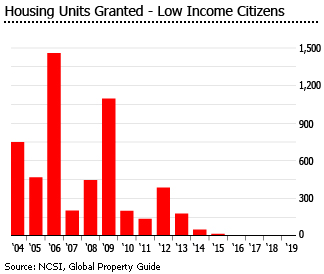
In 2019, the Ministry of Housing approved 193 subsidy applications in Muscat (OMR 4.5 million); 224 applications in Dhofar (OMR 6.7 million); 52 applications in Musandam (OMR 1.12 million); and 104 applications in Buraimi (OMR 2.5 million). However this is far lower than the 1,982 household beneficiaries in 2015, 3,752 in 2014, and 4,137 in 2013.
Oil sector still dominates
Oil and gas revenues will account for about 72% of projected total government revenues of OMR 10.1 billion (US$ 26.3 billion) in the 2020 national budget.
The weakness of Oman’s oil sector continued this year, amidst the pandemic. In January-August 2020, the daily average production fell by 1.4% y-o-y to 957,300 barrels. Oman’s crude oil price averaged US$47.7 per barrel in the first eight months of 2020, down 26% from an average of US$64.7 per barrel a year earlier.

However the Ghazeer project, the second phase of development of the giant Khazzan gas field, is expected to come onstream in 2021, and is projected to deliver an additional 0.5 billion cubic feet per day of gas and over 15,000 barrels per day of condensates.
While Oman continues to enhance its oil recovery techniques to boost oil production, it also has simultaneously pursued a diversification plan “Vision 2040” (a repacking of Vision 2020 launched back in 1995) to boost tourism, modernize agriculture, foster technology and startup ecosystems, and establish free industrial zones.
Tourism offers huge potential
Tourism is one of the most vibrant segments of the Omani economy with arguably the highest untapped potential. Based on the World Travel & Tourism Council’s The Travel & Tourism Competitiveness Report 2019, Oman was ranked the fourth most competitive country in the MENA region in terms of travel and tourism and demonstrated the greatest improvement in the region, moving up 8 notches to 58th worldwide.
Oman welcomed more than 3.5 million tourists in 2019, up 8.14% from the previous year, following about 139% growth from 2009 to 2018. The sector’s strong growth performance in the past decade can be attributed to the government’s continuous effort to improve its infrastructure and international openness. Before the pandemic, Oman introduced online visa application to make entry processes faster and easier. Moreover, a new bus route was also launched last year, connecting Dubai to Muscat.
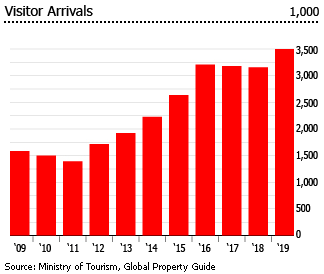
The number of hotel rooms in the Sultanate rose by 14.5% to 25,408 in 2019 from a year earlier. According to the Ministry of Tourism, a total of 66 new hotels and several hotel apartments, camps, heritage inns, and guesthouses, are expected to open between 2020 and 2021.
However due to the pandemic, Oman has suspended all tourist visas and closed its borders since March 15, 2020. The Sultanate will finally reopen for international flights starting October 1 but the list of permitted countries has not yet been released.
Economic slowdown, deteriorating fiscal position
The Omani economy is expected to contract by 2.8% this year, mainly due to the coronavirus outbreak, as well as the oil price slide, based on the IMF projections. It grew by a minuscule 0.5% in 2019, a slowdown from the previous year’s 1.8% growth and far lower than the annual average growth rate of 5% from 2012 to 2016, according to the International Monetary Fund (IMF).
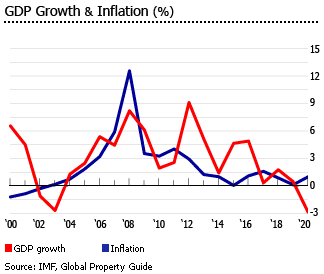
Oman’s fiscal deficit is projected to surge to about 20% of GDP this year, far higher than the previous year’s 8% shortfall, mainly due to a 32% drop in revenues driven by lower oil prices, according to Fitch Ratings. In addition, government debt is expected to rise to over 80% of GDP this year, from 60% of GDP in 2019.
As a result, major credit ratings agencies have recently cut Oman’s rating deeper into junk.
- In March 2020, Standard & Poor’s lowered Oman’s sovereign ratings deeper into junk territory, with a negative outlook, citing higher external risks and indebtedness.
- In June 2020, Moody’s cut Oman’s sovereign rating for the second time this year, to Ba3 – three levels into its non-investment grade scale – and changed its outlook to negative.
- Fitch Ratings also downgraded the country’s long-term foreign currency issuer default rating from BB to BB- in August 2020, following a downgrade last March. The outlook remains negative.
“The downgrade and negative outlook reflect the continued erosion of Oman´s fiscal and external balance sheets, which have accelerated amid low oil prices and the coronavirus shock, despite some progress on underlying fiscal consolidation,” said Fitch Ratings.
In January 11, 2020, Haitham bin Tariq Al Said succeeded to the throne on the death of his cousin, Qaboos Bin Said Al Said. Haitham is expected to continue his predecessor’s economic and social reforms to make the Sultanate less reliant on oil and gas exports for revenue.
Sources:
- Housing (National Centre for Statistics & Information): https://data.gov.om/OMHSNG2016/housing
- Oman Property Market Report 2019-2020 (Cavendish Maxwell): https://issuu.com/cavendish_maxwell/docs/oman_property_market_report_2019-2020
- Oman real estate trading drops 23% YoY to $3.11bn in July 2020 (Construction Week): https://www.constructionweekonline.com/business/267045-oman-real-estate-trading-drops-23-yoy-to-311bn-in-july-2020
- The Property Report – Oman 2020 (Savills): https://www.savills.om/pdf/oman-property-report-2020.pdf
- Oman real estate contracts traded in Aug 2020 peaked $820.9m (Construction Week): https://www.constructionweekonline.com/business/267218-oman-real-estate-contracts-traded-in-aug-2020-peaked-8209m
- Total value of property transactions in Oman reaches $3.1bln (Zawya): https://www.zawya.com/mena/en/business/story/Total_value_of_property_transactions_in_Oman_reaches_31bln-SNG_183946706/
- Mega tourism projects in Oman progressing well: report (Zawya): https://www.zawya.com/mena/en/business/story/Mega_tourism_projects_in_Oman_progressing_well_report-SNG_177414310/
- Muscat residential rental market set to become more tenant-friendly (Oman Daily Observer): https://www.omanobserver.om/muscat-residential-rental-market-set-to-become-more-tenant-friendly/
- Property Report, October 2019 (Al Habib): https://alhabib.om/reports/property-report-october-2019/
- World Economic Outlook Database, April 2020 (International Monetary Fund): https://www.imf.org/external/pubs/ft/weo/2020/01/weodata/weoselser.aspx?a=&c=449&t=1
- Quarterly Statistical Bulletin June 2020 (Central Bank of Oman): https://cbo.gov.om/sites/assets/Documents/Global/Publications/Quarterly/2020/QBJune-2020.pdf
- Monthly Statistical Bulletin July 2020 (Central Bank of Oman): https://cbo.gov.om/sites/assets/Documents/Global/Publications/monthly2020/MonthlyBulletinJuly2020.pdf
- Oman announces further expat visa ban (Arabian Business): https://www.arabianbusiness.com/politics-economics/439469-oman-issues-further-expat-visa-ban#:~:text=In%20November%20last%20year%2C%20Oman,to%20include%20four%20more%20professions.
- Expat workers in Oman decline by 9.3 per cent (Oman Daily Observer): https://www.omanobserver.om/expat-population-decline-by-9-3-in-2020/
- Oman provides housing aid of OMR 48 million for low income families (The Arabian Stories): https://www.thearabianstories.com/2020/03/09/oman-provides-housing-aid-of-omr-48-million-for-low-income-families/
- Oman welcomes over 3.5 million visitors in 2019 (Travel Daily News): https://www.traveldailynews.com/post/oman-welcomes-over-35-million-visitors-in-2019#:~:text=The%20Sultanate%20of%20Oman%20welcomed,of%20visits%20registered%20in%202018.
- This is when Oman will reopen its borders to tourists (Lonely Planet): https://www.lonelyplanet.com/articles/oman-tourism-reopening
- Moody’s downgrades Oman for a second time in 2020 as oil dips (Gulf Business): https://gulfbusiness.com/moodys-downgrades-oman-for-a-second-time-in-2020-as-oil-dips/
- Fitch Downgrades Oman to ´BB-´; Outlook Negative (Fitch Ratings): https://www.fitchratings.com/research/sovereigns/fitch-downgrades-oman-to-bb-outlook-negative-17-08-2020
- UPDATE 1-S&P cuts Oman rating deeper into junk, trims Bahrain´s outlook (Reuters): https://www.reuters.com/article/oman-ratings-idUSL8N2BL08C
- Oman country profile (BBC News): https://www.bbc.com/news/world-middle-east-14654150